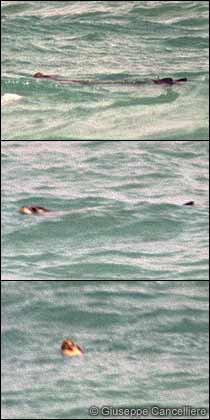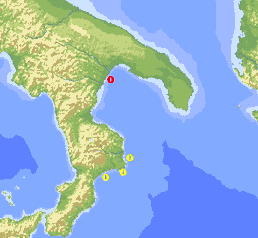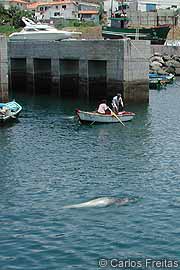

 |
||
 |
||
Vol. 5 (2): November 2002 |
Download this page
|
|
Greece / Italy / Madeira / Mauritania & Western Sahara / Turkey
Italy
|
 |
|
|
The rare visitor to Policoro |
Hailed as "an exceptional event" by WWF Italy president Fulco Pratesi, a Mediterranean monk seal was sighted and caught on film on Saturday 25 May 2002, swimming off the WWF Reserve of Policoro along the Ionian coast of the Basilicata region.
The young seal was sighted initially by two fishermen, who quickly alerted experts at the WWF Wildlife Recovery Centre, a facility involved in the rescue of marine turtles. The fishermen's timely response was attributed to WWF's long-running public awareness efforts in the area.
The seal, nicknamed "Tony" by the fishermen, remained in the area long enough to be caught on film by WWF activists, thus providing the first photographic evidence of the species' possible return to the coasts of southern Italy. While there have been sporadic monk seal sightings in the region over recent years, most notably in Sardinia and Sicily, but also in Puglia and Tuscany [see Sporadic sightings continue in southern Italy, TMG 5 (1): May 2002], firm documentary evidence has remained elusive.
When WWF personnel first arrived on the scene, they reportedly found the seal floating languidly in the water, raising concerns that the animal might be dead or in difficulty. Such fears, however, were quickly dispelled as the animal resumed swimming along the shoreline. Indeed, Tony's physical appearance suggested that the animal was in good health and may only been resting or sleeping. Retreating to a safer distance, the WWF activists subsequently followed the animal for more than a hour, reporting that Tony showed no fear of human presence.
Acting swiftly to reinforce protection for the seal, the local harbour master delivered an alert to the surrounding area, reminding inhabitants that Monachus monachus is a strictly-protected species under Italian law.
According to experts of the Gruppo Foca Monaca and ICRAM, who monitor sightings of the species in Italy, "Tony" was probably a vagrant individual roaming outside its customary habitat – exploratory behaviour not uncommon for juvenile monk seals, particularly males. They speculated that the seal may have originated from a colony among the Ionian Islands of Greece, such as Cephalonia or Zakynthos.
Underlining the extraordinary nature of the sighting, some reports suggest that the last monk seal observation to take place in the Basilicata region may have been a century ago.
 |
|
|
Monk seal sightings occurring between March-May 2002 (yellow circles indicate non-photographed observations; red circle indicates the photographed sighting of Policoro) |
"The presence of the monk seal is an exceptional event and is a result of the close collaboration between WWF and the local fishermen," said Fulco Pratesi in a WWF press release. "This first documented evidence of its presence will allow WWF to begin a more in-depth research programme on the monk seal in Italy."
Other monk seal sightings (making a total of 6 in all) [see Sporadic sightings continue in southern Italy, TMG 5 (1): May 2002] had previously been reported between the third week of March and the end of April 2002, between the Gulf of Squillace and the port of Crotone. In most of those cases, observers reported seeing a seal black in colour and relatively small (70 – 1.30 cm in length). Since some of the sightings had occurred within the Marine Protected Area of Capo Rizzuto, a special monitoring programme and training workshop, aimed at ensuring a better coastal surveillance and protection scheme, was conducted by ICRAM with the MPA's staff and the marine corps operating along the coasts between Reggio Calabria and Crotone.
It is possible that the March-April sightings in the southwestern portion of Calabria may be of the same individual photographed farther north in the Policoro area, although the images suggest that the photographed individual is longer than the size reported in sightings information collected in Calabria. If, however, the sightings are attributable to the same individual, this seal would have travelled at least 200 km within a two month time frame. – Gruppo Foca Monaca.
 |
|
|
12 July 2002: A curious monk seal visits the fishing port of Caniçal |
Researchers continue to monitor a marked increase in monk seal sightings around the main island of Madeira [see Madeira island observations, TMG 4 (2): November 2001 and Are monk seals recolonising Madeira island? TMG 4 (1): May 2001].
So far this year, over 30 observations have been reported from different locations around Madeira, but with a concentration near the village of Caniçal in the southeast and the Naval Club in Funchal, the island's capital.
These two places are highly frequented by people, with the result that many had the opportunity of observing these monk seals.
The reaction of the Madeiran community has generally been good but 4 "accidents" have already occurred involving monk seals. In these cases, it appears that the injuries were sustained when people tried to approach or play with the animals.
The Parque Natural da Madeira is therefore preparing a public awareness campaign, advising people about the monk seal's return to the island and how to behave when they encounter a seal.
It is also planning to survey the Madeiran coastline in an effort to identify the most suitable monk seal habitat available.
As recorded in previous issues of TMG, we believe that the monk seal may be in the process of recolonising the main island of Madeira as the recovering population in the Desertas Islands Nature Reserve begins to disperse in search of new habitat. – Rosa Pires, Parque Natural da Madeira.
A public competition was held on Madeira to find names for the three monk seal pups that were born last year. The winning entries were "Funchinha", which is related with the word "fennel" (from which the name of the Madeiran capital – Funchal – also originates), "Esponja" which means sponge, and "Adamastor".
Adamastor was the name given by Luís de Camões in his literary work "Lusiadas" to the monster that tormented Portuguese navigators at Boa Esperança Cape in South Africa.
The competition results are available in full on the following web site:
http://www.gov-madeira.pt/sra/geomedia/balcaoverde/Sondagens/Lobo_Marinho/index.htm
– Rosa Pires, Parque Natural da Madeira.
Two monk seal pups have been born in the Desertas Islands Nature Reserve so far this year, one in February and the other in July.
We also expect the females "Birisca" and "Desertinha" to give birth some time in October or November – as they have done every year since 1997. – Rosa Pires, Parque Natural da Madeira.
Weam is now one year old. We all know her history from May's issue of The Monachus Guardian [see Rescue, release and post-release monitoring of Weam, TMG 5 (1): May 2002] and fortunately we can keep telling her story.
Following her release from the beach known as Barco de Azúcar, close to the breeding caves, Weam began using a couple of haul-outs around 3 km south of the release site and around 6 km from the colony caves. She spent most of the time resting on the beach and performing shy foraging trips at sea in the intertidal area.
She remained in this area for around 15 days, and no signs of weakness or weight loss were observed. Afterwards she began a period of wider dispersal until, a month later, she returned to the western coast of the Cabo Blanco peninsula.
Although venturing farther north than the breeding colony caves, Weam has since returned to the south and appears to have established herself on the two contiguous beaches of her release site (Campo de Tiro and Barco de Azúcar).
Seventy-five percent of our observations since May – when we last reported Weam's progress in TMG – have been on these two beaches.
 |
|
|
Weam, monitored by guards |
Since her release on 27 February 2002, Weam has been intensively monitored from the distance by the CBD-Habitat team in order to eliminate any potential human disturbance. As a matter of fact, the site where Weam has now established herself is located within the marked protection area permanently monitored by wardens [see Conservation actions on the Cabo Blanco peninsula – a new approach, this issue].
So far, Weam is the only female monk seal known to haul-out on open beaches, the original habitat of the species from which they were displaced because of human persecution and disturbance.
The provisional success of this reintroduction is, we believe, due to two remarkable facts. The first is that Weam accomplished a natural and spontaneous acclimatization during the 15 days she spent in the vicinity of the release area. That period allowed her to recognise open beaches as haul-out places, and to develop a homing instinct to this area. The second is that the permanent surveillance of the marked protection area has allowed her to find the kind of undisturbed habitat that her species requires to survive.
The conclusion we can draw from Weam's experience is that an acclimatization period increases the possibility of survival for rehabilitated pups, allowing them to familiarize themselves with open beaches close to the breeding colony and to recolonize this natural habitat historically used by the species.
If other individual seals were to follow Weam's lead, the consequences of such a change in habitat use might be significant, helping to reduce the very high pup mortality rate – the result of breeding in caves prone to storm surges. The recolonization of open beaches could also reduce the potentially catastrophic effects of a possible collapse of the current breeding caves.
In two years or so, we hope it will be possible to read in The Monachus Guardian news about the birth of Weam's pup on an open beach. – Miguel Angel Cedenilla, Ingrid Mozetich and Fernández de Larrinoa.
 |
|
|
Artisanal fishermen in Mauritania receiving safety equipment and conservation awareness material |
As related in this issue's In Focus article, Conservation actions on the Cabo Blanco peninsula – a new approach, targeted social and development aid can yield significant bonuses for the conservation of endangered species, particularly in countries struggling to escape the clutches of poverty.
In the article, authors Pablo Fernández de Larrinoa, Ingrid Mozetich and Miguel Angel Cedenilla explain how development assistance for Mauritania's impoverished artisanal fishermen – including a new fish market in Nouadhibou -– has resulted in meaningful protection for the "Coast of Seals". This includes the establishment of a guarded protection zone – incorporating the two main breeding caves at its core – covering around 6 km of coast.
The eagerly awaited report of the Population and Habitat Viability Assessment Workshop (PHVA), held in Valsaín, Spain, in November 2001 has now been published by the Conservation Breeding Specialist Group (CBSG) of IUCN.
As related in previous issues of TMG, the Workshop's principle aim was to consult the scientific community and the authorities of range states on wide ranging issues relating to the Monk Seal Recovery Plan in the Atlantic, and to further develop and refine its technical aspects [see International workshop wrestles with Atlantic issues, TMG 5 (1): May 2002, and Recovery Plan outlines objectives, TMG 4 (1): May 2001].
The Plan has already been officially endorsed by representatives of the four nations directly involved in the conservation of the Mediterranean monk seal in the region – Mauritania, Morocco, Portugal and Spain – under the auspices of the Bonn Convention.
Editor's note: An electronic (PDF) version of the report is now available for download in the Monachus Library:
González, L.M., B. Heredia, A. Araujo, I. Robinson, J. Worms, P.S. Miller, and U. Seal (eds.). 2002. Population and Habitat Viability Assessment for the Mediterranean Monk Seal (Monachus monachus) in the Eastern Atlantic. Workshop Report. Apple Valley, MN: IUCN/SSC Conservation Breeding Specialist Group: 1-126.
Mediterranean News continues with Turkey...
Copyright © 2002 The Monachus Guardian. All Rights Reserved |